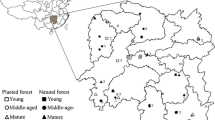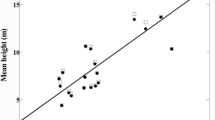Abstract
Quantification of carbon budgets and cycling in Japanese cedar (Cryptomeria japonica D. Don) plantations is essential for understanding forest functions in Japan because these plantations occupy about 20% of the total forested area. We conducted a biometric estimate of net ecosystem production (NEP) in a mature Japanese cedar plantation beneath a flux tower over a 4-year period. Net primary production (NPP) was 7.9 Mg C ha−1 year−1 and consisted mainly of tree biomass increment and aboveground litter production. Respiration was calculated as 6.8 (soil) and 3.3 (root) Mg C ha−1 year−1. Thus, NEP in the plantation was 4.3 Mg C ha−1 year−1. In agreement with the tower-based flux findings, this result suggests that the Japanese cedar plantation was a strong carbon sink. The biometric-based NEP was higher among most other types of Japanese forests studied. Carbon sequestration in the mature plantation was characterized by a larger increment in tree biomass and lower mortality than in natural forests. Land-use change from natural forest to Japanese cedar plantation might, therefore, stimulate carbon sequestration and change the carbon allocation of NPP from an increment in coarse woody debris to an increase in tree biomass.




Similar content being viewed by others
Abbreviations
- GPP:
-
Gross primary production
- NEP:
-
Net ecosystem production
- NEE:
-
Net ecosystem exchange (NEP = −NEE)
- NPP:
-
Net primary production
- B :
-
Biomass
- CWD:
-
Coarse woody debris
- SOM:
-
Soil organic matter
- TBCF:
-
Total belowground carbon flux
References
Ando T, Hatiya K, Doi K, Kataoka H, Kato Y, Sakaguchi K (1968) Studies on the system of density control of Sugi (Cryptomeria japonica) stand. Bull Gov For Exp Sta 209:1–76 (in Japanese with English summary)
Baldocchi DD (2003) Assessing the eddy covariance technique for evaluating carbon dioxide exchange rates of ecosystems: past, present and future. Glob Chang Biol 9:479–492
Bekku YS, Sakata T, Nakano T, Koizumi H (2009) Midday depression in root respiration of Quercus crispula and Chamaecyparis obtusa: its implication for estimating carbon cycling in forest ecosystems. Ecol Res 24:865–871
Canadell JG, Le Quere C, Raupach MR, Field CB, Buitenhuis ET, Ciais P, Conway TJ, Gillett NP, Houghton RA, Marland G (2007) Contributions to accelerating atmospheric CO2 growth from economic activity, carbon intensity, and efficiency of natural sinks. Proc Nat Acad Sci USA 104:18866–18870
Clinton BD, Thornley JHM (1999) Fine root respiration in mature eastern white pine (Pinus strobus) in situ; importance of CO2 in controlled environments. Tree Physiol 19:475–479
Curtis PS, Hanson PJ, Bolstad P, Barford C, Randolph JC, Schmid HP, Wilson KB (2002) Biometric and eddy-covariance based estimates of annual carbon storage in five eastern North American deciduous forests. Agric For Meteorol 113:3–19
Denman KL, Brasseur G, Chidthaisong A, Ciais P, Cox PM, Dickinson RE, Hauglustaine D, Heinze C, Holland E, Jacob D, Lohmann U, Ramachandran S, da Silva Dias PL, Wofsy SC, Zhang X (2007) Couplings between changes in climate system and biogeochemistry. In: Solomon S, Qin D, Manning M, Chen Z, Marques M, Averyt KB, Tignor M, Miller HL (eds) Climate change 2007: the physical science basis. Contribution of Working Group I to Fourth Assessment Report of the Intergovernmental Panel on Climate Change (IPCC). Cambridge University Press, Cambridge, UK, pp 499–587
Ehman JL, Schmid HP, Grimmond CSB, Randolph JC, Hanson PJ, Wayson CA, Cropley FD (2002) An initial intercomparison of micrometeorological and ecological inventory estimates of carbon exchange in a mid-latitude deciduous forest. Global Change Biol 8:575–589
Fukuda M, Iehara T, Matsumoto M (2003) Carbon stock estimates for sugi and hinoki forests in Japan. For Ecol Manage 184:1–16
Gough CM, Vogel CS, Schmid HP, Su H-B, Curtis PS (2008) Multi-year convergence of biometric and meteorological estimates of forest carbon storage. Agric For Meteorol 148:158–170
Hanson PJ, Edward NT, Garten CT, Andrews JA (2000) Separating root and soil microbial contribution: a review of method and observations. Biogeochemistry 48:115–146
Hayashi S, Sakai K (1972) Competition in relation to growth of tree in Cryptomeria Forests. J Jpn For Soc 54:218–225 (in Japanese with English summary)
Hirata R, Hirano T, Saigusa N, Fujimura Y, Inukai K, Kitamori Y, Yamamoto S (2007) exchange of a temperate larch forest. Agric For Meteorol 148:761–775
Hirata R, Saigusa N, Yamamoto S, Ohtani Y, Ide R, Asanuma J, Gamo M, Hirano T, Kondo H, Kosugi Y, Li S-G, Nakai Y, Takagii K, Tanig M, Wang H (2008) Spatial distribution of carbon balance in forest ecosystems across East Asia. Agric For Meteorol 148:761–775
Hiura T (2005) Estimation of aboveground biomass and net biomass increment in a cool temperate forest on a landscape scale. Ecol Res 20:271–277
Ito T, Ueda M, Maiyauchi H (1972) Studies on the classification of the forest site unit in Ibaraki prefecture (II). Variation of the nutrient content in Sugi (Cryptomeria japonica) needles according to tree age, site quality and forest unit. J Jpn For Soc 54:74–79 (in Japanese with English summary)
Japan FAO Association (1997) Forests and forestry in Japan, 2nd edn. Japan FAO Association, Tokyo
Karizumi N (1974a) The mechanism and function of tree root in the process of forest production I. Method of investigation and estimation of the root biomass. Bull Gov Exp Sta 259:1–99
Karizumi N (1974b) The mechanism and function of tree root in the process of forest production II. Root biomass and distribution in stands. Bull Gov Exp Sta 167:1–88
Kimura M, Funakoshi M, Sudo S, Masuzawa T, Nakamura T, Matsuda K (1982) Productivity and mineral cycling in an oak coppice forest. 2. Annual net production of the forest. Bot Mag Tokyo 95:359–373
Kira T (1977) Production rates. In: Shidei T, Kira T (eds) Primary production of Japanese forests–Productivity of terrestrial communities. University of Tokyo Press, Tokyo, pp 101–114
Kominami Y, Miyama T, Tamai K, Nobuhiro T, Goto Y (2003) Characteristics of CO2 flux over a forest on complex topography. Tellus 55B:313–321
Kominami Y, Jomura M, Dannoura M, Goto Y, Tamai K, Miyama T, Kanazawa Y, Kaneko S, Okumura M, Misawa N, Hamada S, Sasaki T, Kimura H, Ohtani Y (2008) Biometric and eddy-covariance-based estimates of carbon balance for a warm-temperate mixed forest in Japan. Agric For Meteorol 148:723–737
Lee N-Y, Koizumi H (2009) Estimation of the number of sampling points required for the determination of soil CO2 efflux in two types of plantation in a temperate region. J Ecol Field Biol 32:67–73
Lee M-S, Lee J-S, Koizumi H (2008) Temporal variation in CO2 efflux from soil and snow surfaces in a Japanese cedar (Cryptomeria japonica) plantation, central Japan. Ecol Res 23:777–785
Litton CM, Taich JW, Ryan MG (2007) Carbon allocation in forest ecosystems. Glob Chang Biol 13:2089–2109
Nakane K (1995) Soil carbon cycling in a Japanese cedar (Cryptomeria japonica) plantation. For Ecol Manage 72:185–197
Noguchi K, Konôpka B, Satomura T, Kaneko S, Takahashi M (2007) Biomass and production of fine roots in Japanese forest. J For Res 12:83–95
Ogawa K, Hagiahara A (2003) Self-thinning and size variation in a sugi (Cryptomeria japonica D. Don) plantation. For Ecol Manage 174:413–421
Ohashi M, Gyokusen (2007) Temporal change in spatial variability of soil respiration on a slope of Japanese cedar (Cryptomeria japonica D. Don) forest. Soil Biol Biochem 39:1130–1138
Ohtsuka T, Mo W, Satomura T, Inatomi M, Koizumi H (2007) Biometric based carbon flux measurements and net ecosystem production (NEP) in a temperate deciduous broad-leaved forest beneath a flux tower. Ecosystems 10:324–334
Osumi K, Mori M, Sakurai N, Saitou K, Satou S, Seki T (2000) Long term growth records of old-aged sugi (Cryptomeria japonica) plantations in Akita Prefecture, North-eastern Japan. J Jpn For Soc 82:179–187 (in Japanese with English summary)
Randerson JT, Chapin FS III, Harden JW, Neff JC, Harmon ME (2002) Net ecosystem production: a comprehensive measure of net carbon accumulation by ecosystems. Ecol Appl 12:937–947
Research Group on Forest Productivity of the Four Universities (1966) Studies on the productivity of the forest. Part III. Productivity of Sugi forests. Nippon Ringyo Gijyutsu Kyokai, Tokyo, pp 21–29 (in Japanese)
Saitoh MT, Tamagawa I, Muraoka H, Lee N-YM, Yashiro Y, Koizumi H (2010) Carbon dioxide exchange in a cool-temperate evergreen coniferous forest over complex topography in Japan during two years with contrasting climates. J Plant Res. doi:10.1007/s10265-009-0308-7
Schowalter TD, Hargrove WW, Crossley DA (1986) Herbivory in forested ecosystems. Annu Rev Entomol 31:177–196
Shibata H, Hiura T, Tanaka Y, Takagi K, Koike T (2005) Carbon cycling and budget in a forested basin of southwestern Hokkaido, northern Japan. Ecol Res 20:325–331
Shinjo H, Kato A, Fujii K, Mori K, Funakawa S, Kosaki T (2006) Carbon dioxide emission derived from soil organic matter decomposition and root respiration in Japanese forests under different ecological conditions. Soil Sci Plant Nutr 52:233–242
Shutou K, Nakane K (2004) Change in soil carbon cycling for stand development of Japanese cedar (Cryptomeria japonica) plantations following clear-cutting. Ecol Res 19:233–244
Tadaki Y (1977) Leaf biomass. In: Shidei T, Kira T (eds) Primary production of Japanese forests–Productivity of terrestrial communites. University of Tokyo Press, Tokyo, pp 39–44
Thomas PA, Packham JR (2007) Introduction: Forest basics. In: Thomas PA, Packham JR (eds) Ecology of woodland and forests. Cambrigde University Press, USA, pp 1–38
Toda H (2007) Nurturing forests (Ikurin). In: Shinrin Ringyo Jitsumu Hikkei Henshu Iinkai (ed) Shinrin Ringyo Jitsumu Hikkei, Asakura Shoten, Tokyo, pp 39–63 (in Japanese)
Watanabe H, Mogi Y (2005) Soil carbon stocks in mature Sugi and Hinoki stands (Sourei Sugi, Hinoki jinnkourin ni okeru rinbun no tanso choryuryo). Bull Gifu Pre Res Inst For 34:11–18 (in Japanese)
Yamashita T, Kasuya N, Nishimura S, Takeda H (2004) Comparison of two coniferous plantations in central Japan with respect to forest productivity, growth phenology and soil nitrogen dynamics. For Ecol Manage 200:215–226
Acknowledgments
We thank Mr. Kenji Kurumado and Mr. Yasunori Miyamoto of Gifu University for their assistance in the field. We also thank Drs. Ichiro Tamagawa, Hiroyuki Muraoka, and Shin Nagai of Gifu University for their kind cooperation in the field survey and in providing meteorological data. This study was supported financially by the Twenty-first Century Centers of Excellence (COE) program “Satellite Ecology” of Gifu University and by the Japan Society for Promotion of Science (JSPS) A3 Foresight Program.
Author information
Authors and Affiliations
Corresponding author
Rights and permissions
About this article
Cite this article
Yashiro, Y., Lee, NY.M., Ohtsuka, T. et al. Biometric-based estimation of net ecosystem production in a mature Japanese cedar (Cryptomeria japonica) plantation beneath a flux tower. J Plant Res 123, 463–472 (2010). https://doi.org/10.1007/s10265-010-0323-8
Received:
Accepted:
Published:
Issue Date:
DOI: https://doi.org/10.1007/s10265-010-0323-8




